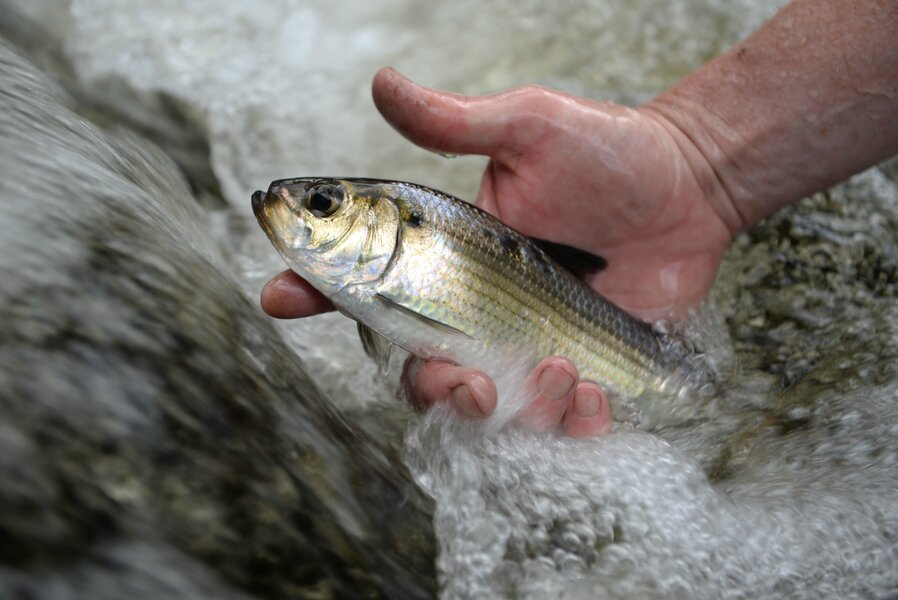How big data could save aquatic species
Loading...
Last week, the US Forest Service announced what is perhaps its loftiest conservation goal ever: to map every aquatic animal in the Western states.
By next summer, the department hopes to release the first-ever Aquatic Environmental DNA Atlas. Using new DNA testing technology, researchers plan to comb rivers and streams for the genetic material of every otter, salmon, and water bug west of the Mississippi. The resulting biodiversity map, cataloging thousands of species by population boundary, would be a public resource.
Such a map could inform future land management decisions and help allocate limited conservation funding, researchers say. Meanwhile, the technology behind the map could identify unknown populations or invasive species.
Researchers plan to populate the map using what is essentially souped-up PCR technology. The PCR (polymerase chain reaction) technique, which allows scientists to amplify and analyze sections of DNA, was originally developed in 1983 for use in paternity tests and disease diagnosis. New developments allow researchers to identify free-floating DNA in water samples.
Current technology can only identify one species at a time, but researchers are exploring ways to extract multiple DNA fragments from a single stream sample. That could happen as early as next year, Michael Schwartz, the director of the Forest Service's National Genomics Center for Wildlife and Fish Conservation, told the Associated Press.
Such a tool would be able to survey large areas very quickly – in other words, environmental DNA (eDNA) could help conservationists cast wider nets.
“One of the problems [with conservation] is that you have to look physically,” John Kelly, a professor of biology at the University of New Haven, tells The Christian Science Monitor in a phone interview. “It’s time intensive, and you always run the risk of simply missing something. Any tool that uses environmental DNA is intriguing because it’s going to integrate along large areas, potentially the whole watershed.”
That’s good news for aquatic species in particular, since they’re generally harder to spot with the naked eye. Using eDNA, researchers hope to be able to identify unknown populations or ones that fell through the cracks in specific regions.
“We tend to think in terms of political boundaries, but animal populations don’t work that way,” Dr. Kelly says. “With a tool like this, you can get a better sense of population distribution and target your efforts.”
But eDNA isn’t a magic bullet for conservation. Genetic information can’t convey population size, nor can it substitute an understanding of the natural history of specific species and the greater community ecology. Currently, a group of Pew Marine Fellows are working to identify other potential limitations of this promising new technology.
“So far, eDNA is actually working better in some applications than it even should theoretically, and we are trying to figure out how come,” Les Kaufman, a marine biologist at Boston University, tells the Monitor in an email. “Though yes, that is good news, we are reluctant to stretch any claims for eDNA too far until we know more.”
Researchers will eventually combine their data with stream temperatures, topography, and local weather patterns, to help them understand more deeply how ecosystems function – which, in turn, would allow them to better allocate limited conservation resources. And as tech continues to improve, big data may help pave the way for a more holistic approach to environmental research.
There are three fundamental styles of conservation, Dr. Kaufman explains. Species conservation is the protection of endangered or threatened animals. Land and habitat conservation focuses on preserving habitats, which can, in turn, maintain animal populations. The most recent approach, known as ecosystem service mapping and valuation, weighs the first two against human well-being.
“But all are really about the same things,” Kaufman says. “Species cannot exist without their habitats, and people are not motivated to save anything if they are unable to see the benefits to themselves.”
As big data grows ever-important in scientific research, these factors may become clearer. By cross-referencing large data sets on temperature, urban expansion, animal populations, and geography – a virtually impossible task just a few decades ago – researchers could more accurately link changes in biodiversity to factors like urban development and anthropogenic climate change.
Earlier this year, a marine biologist from the University of Washington began digitizing every fish known to man – more than 25,000 species – via computed tomography (CT) scanning. The project, researchers say, would allow scientists to conduct physiological or behavioral research on any one of those specimens without ever leaving their computer.
But even big data cannot replace the human touch in matters of conservation – not yet, at least.
“You still have to go out and see what’s there,” says Kelly, of the University of New Haven. “It’s not going to replace what we’re already doing, but it’s another tool in the toolbox. And it sounds like a good one.”








